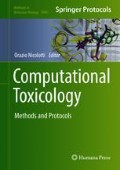Abstract
In this chapter we present and discuss, with the aid of several representative case studies from drug discovery and computational toxicology, a new cheminformatics platform, Enalos Suite, that was developed with open source and freely available software. Enalos Suite (http://enalossuite.novamechanics.com/) was designed and developed as a useful tool to address a variety of cheminformatics problems, given that it expedites tasks performed in predictive modeling and allows access, data mining and manipulation for multiple chemical databases (PubChem, UniChem, etc.). Enalos Suite was carefully designed to permit its extension and adjustment to the special field of interest of each user, including, for instance, nanoinformatics, biomedical, and other applications. To demonstrate the functionalities of Enalos Suite that are useful in different cheminformatics applications, we present indicative case studies that include the exploitation of chemical databases within a drug discovery project, the calculation of molecular descriptors, and finally the development of a predictive QSAR model validated according to OECD principles. We aspire that at the end of this chapter, the reader will capture the effectiveness of different functionalities included in the Enalos Suite that could be of significant value in a multitude of cheminformatics applications.
Access this chapter
Tax calculation will be finalised at checkout
Purchases are for personal use only
References
Todeschini R, Consonni V (2010) Molecular descriptors for chemoinformatics. Wiley- VCH, Weinheim
Leonis G et al (2016) Handbook of computational chemistry. Springer, New York, NY
Willett P (2002) Chemistry plans a structural overhaul The rising tide of data being generated by high-throughput. Nature 419:4–7
Leach Andrew R, Gillet VJ (2007) An introduction to chemoinformatics, revised Ed. Springer, New York, NY
Melagraki G, Afantitis A (2016) Editorial: towards open access for cheminformatics. Comb Chem High Throughput Screen 19:260–261
Vrontaki E, Melagraki G, Mavromoustakos T, Afantitis A (2014) Exploiting ChEMBL database to identify indole analogs as HCV replication inhibitors. Methods 71:4–13
Hong H, Xie Q, Ge W et al (2008) Mold2, molecular descriptors from 2D structures for chemoinformatics and toxicoinformatics. J Chem Inf Model 48:1337–1344
Tropsha A (2010) Best practices for QSAR model development, validation, and exploitation. Mol Informatics 29:476–488
Melagraki G, Afantitis A, Sarimveis H et al (2006) A novel RBF neural network training methodology to predict toxicity to Vibrio fischeri. Mol Divers 10:213–221
Varsou D-D, Melagraki G, Sarimveis H, Afantitis A (2017) MouseTox: an online toxicity assessment tool for small molecules through Enalos Cloud platform. Food Chem Toxicol 110:83–93
Melagraki G, Ntougkos E, Rinotas V et al (2017) Cheminformatics-aided discovery of small-molecule Protein-protein interaction (PPI) dual inhibitors of Tumor Necrosis Factor (TNF) and Receptor Activator of NF-κB Ligand (RANKL). PLoS Comput Biol 13:e1005372
Melagraki G, Afantitis A (2014) Enalos InSilicoNano platform: an online decision support tool for the design and virtual screening of nanoparticles. RSC Adv 4:50713–50725
NovaMechanics Ltd (2017) NovaMechanics Ltd. http://www.novamechanics.com/index.php/what-we-do/software/. Accessed 7 Apr 2017
Krause S, Willighagen E, Steinbeck C (2000) JChemPaint - Using the collaborative forces of the internet to develop a free editor for 2D chemical structures. Molecules 5:93–98
Chemical Identifier Resolver. https://cactus.nci.nih.gov/chemical/structure. Accessed 22 Dec 2017
Kim S, Thiessen PA, Bolton EE et al (2016) PubChem substance and compound databases. Nucleic Acids Res 44:D1202–D1213
Melagraki G, Afantitis A (2015) A risk assessment tool for the virtual screening of metal oxide nanoparticles through enalos insiliconano platform. Curr Top Med Chem 15:1827–1836
Chen B, Wild DJ (2010) PubChem BioAssays as a data source for predictive models. J Mol Graph Model 28:420–426
Cheng T, Pan Y, Hao M et al (2014) PubChem applications in drug discovery: a bibliometric analysis. Drug Discov Today 19:1751–1756
Ojha PK, Roy K (2018) Development of a robust and validated 2D-QSPR model for sweetness potency of diverse functional organic molecules. Food Chem Toxicol 112:551
Melagraki G, Afantitis A, Sarimveis H et al (2007) A novel QSPR model for predicting θ (lower critical solution temperature) in polymer solutions using molecular descriptors. J Mol Model 13:55–64
Afantitis A, Melagraki G, Sarimveis H et al (2008) Development and evaluation of a QSPR model for the prediction of diamagnetic susceptibility. QSAR Comb Sci 27:432–436
Melagraki G, Afantitis A (2011) Ligand and structure based virtual screening strategies for hit-finding and optimization of hepatitis C virus (HCV) inhibitors. Curr Med Chem 18:2612–2619
Afantitis A, Melagraki G, Sarimveis H et al (2006) A novel QSAR model for evaluating and predicting the inhibition activity of dipeptidyl aspartyl fluoromethylketones. QSAR Comb Sci 25:928–935
Leonis G, Melagraki G, Afantitis A (2016) Open source chemoinformatics software including KNIME analytics platform among a multitude. Springer, New York, NY, pp 2201–2230
National Center for Biotechnology Information (2012) PubChem BioAssay Database, AID=651744. https://pubchem.ncbi.nlm.nih.gov/bioassay/651744. Accessed 3 Jan 2017
Melagraki G, Afantitis A, Sarimveis H et al (2010) In silico exploration for identifying structure-activity relationship of MEK inhibition and oral bioavailability for isothiazole derivatives. Chem Biol Drug Des 76:397–406
Papa E, Sangion A, Arnot JA, Gramatica P (2018) Development of human biotransformation QSARs and application for PBT assessment refinement. Food Chem Toxicol 112:535
Alves VM, Muratov EN, Zakharov A et al (2018) Chemical toxicity prediction for major classes of industrial chemicals: is it possible to develop universal models covering cosmetics, drugs, and pesticides? Food Chem Toxicol 112:526
Afantitis A, Leonis G, Gambari R, Melagraki G (2017) Consensus Predictive Model for the prediction of Human K562 Cell Growth Inhibition through Enalos Cloud Platform. ChemMedChem. https://doi.org/10.1002/cmdc.201700675
National Center for Biotechnology Information (2016) SANGER: inhibition of human K-562 cell growth in a cell viability assay. https://pubchem.ncbi.nlm.nih.gov/bioassay/742260. Accessed 19 Dec 2017
Author information
Authors and Affiliations
Corresponding authors
Editor information
Editors and Affiliations
Rights and permissions
Copyright information
© 2018 Springer Science+Business Media, LLC, part of Springer Nature
About this protocol
Cite this protocol
Varsou, DD., Nikolakopoulos, S., Tsoumanis, A., Melagraki, G., Afantitis, A. (2018). Enalos Suite: New Cheminformatics Platform for Drug Discovery and Computational Toxicology. In: Nicolotti, O. (eds) Computational Toxicology. Methods in Molecular Biology, vol 1800. Humana Press, New York, NY. https://doi.org/10.1007/978-1-4939-7899-1_14
Download citation
DOI: https://doi.org/10.1007/978-1-4939-7899-1_14
Published:
Publisher Name: Humana Press, New York, NY
Print ISBN: 978-1-4939-7898-4
Online ISBN: 978-1-4939-7899-1
eBook Packages: Springer Protocols

